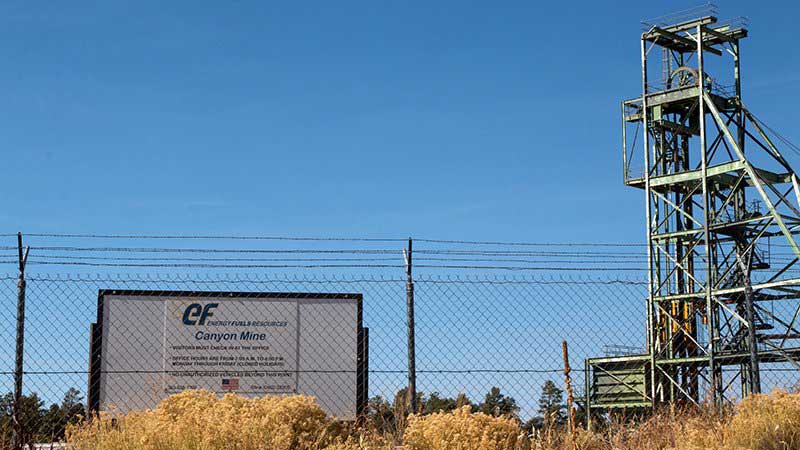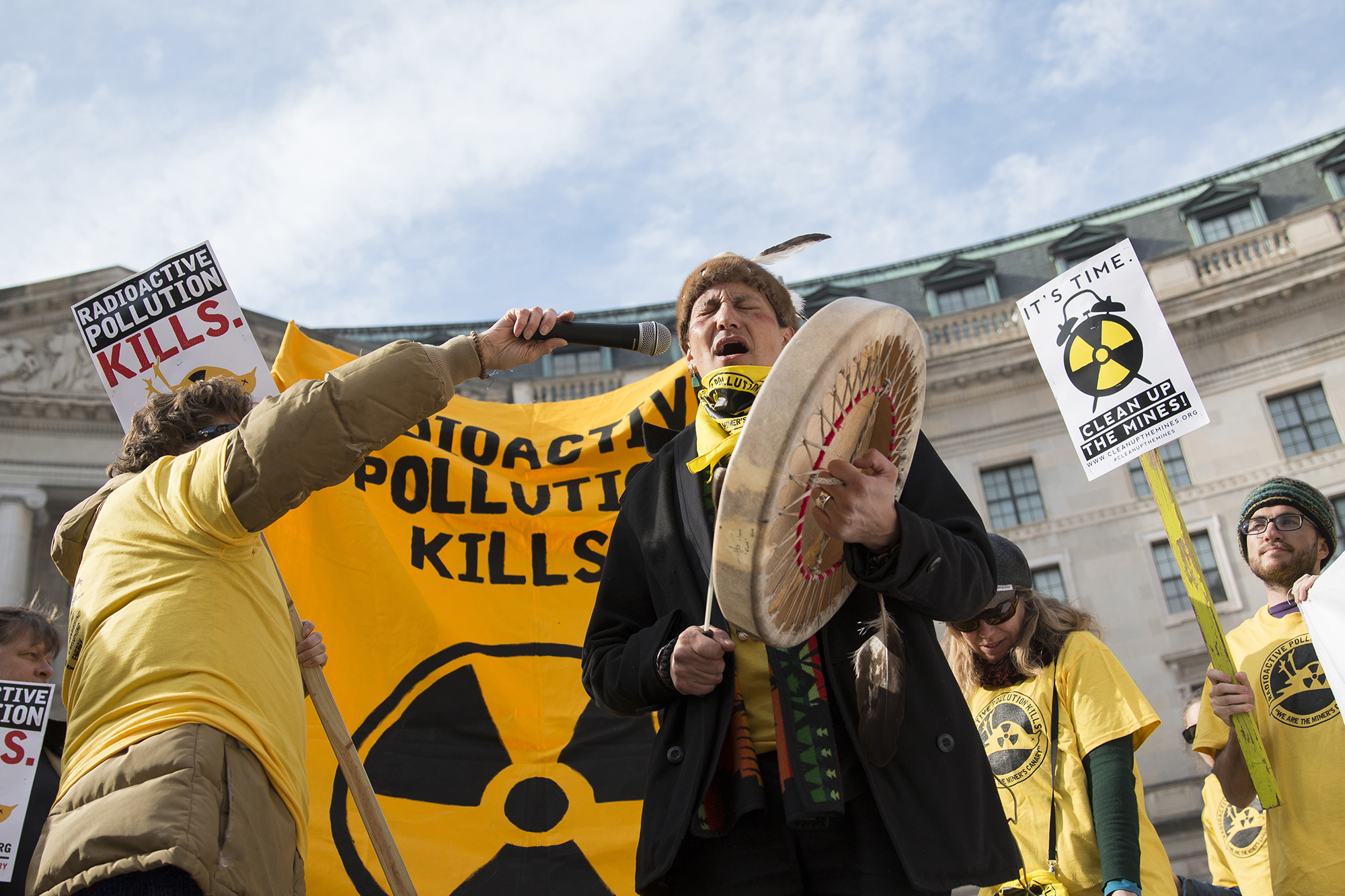 VIEW LARGER The Canyon Mine, about 15 miles south of the Grand Canyon, was approved in 1986 but has not produced any uranium, its owners say, in part because subsidized competition from foreign countries like China and Russia keeps prices too low.
VIEW LARGER The Canyon Mine, about 15 miles south of the Grand Canyon, was approved in 1986 but has not produced any uranium, its owners say, in part because subsidized competition from foreign countries like China and Russia keeps prices too low. PHOENIX – Environmentalists are blasting a Trump administration call for “bold action to revive and strengthen the uranium mining industry,” an industry whose history they say has left a “toxic trail” through the Grand Canyon.
They are responding to a report last week by the Department of Energy’s Nuclear Fuel Working Group, which called for the government to support both uranium mining and nuclear power technology to preserve national security.
The first step in that plan is a proposal for $150 million in next year’s Energy Department’s budget to buy and stockpile U.S.-mined uranium, the report said.
“As a matter of national security, it is critical that we take bold steps to preserve and grow the entire U.S. nuclear energy enterprise,” Energy Secretary Dan Brouillette said in a statement announcing the report. He said a lack of U.S. progress on nuclear energy and technology “has threatened our national interest and national security.”
Environmentalists say there is no need to protect a “sagging” uranium mining industry and fear the report will lead the administration to slash environmental laws and regulations to allow for more mining. That is a particular concern in northern Arizona, where there are hundreds of abandoned uranium mines that still pose health risks, they said.
“We cannot turn a blind eye to past mining in the region and incentivize new mining on public lands without even fully remediating environmental and public health hazards already present,” Rep. Tom O’Halleran, D-Sedona, said in a statement responding to the report.
O’Halleran said there are more than 520 abandoned uranium mines on the Navajo Nation alone. The Environmental Protection Agency cites health threats from waste rock piled outside those mines that can contaminate surface and groundwater, and winds that can carry radioactive dust into communities.
The Obama administration imposed a 20-year moratorium in 2012 on uranium mining on 1 million acres around the Grand Canyon, and the House last year passed a bill to make that ban law. But the bill has stalled in the Senate and the moratorium could be overturned by another administration.
Longtime uranium supporter Rep. Paul Gosar, R-Prescott, applauded the working group’s report, saying there is no reason the U.S. should be importing “over 90% of the uranium necessary for domestic reactors from hostile countries like China and Russia when we have an ample supply here at home.”
Gosar said domestic uranium production would create “good-paying jobs, especially right here in Arizona,” downplaying the threat of environmental risks.
“Unlike other countries around the world, the United States has some of the strictest environmental and labor standards in the world,” Gosar said in a statement. “We can develop these bountiful resources and conserve our environment at the same time.”
Taylor McKinnon, a senior public lands campaigner with the Center for Biological Diversity, said history proves otherwise.
“It’s egregious that anyone is considering new mining let alone federal purchasing of domestic uranium or other policy measures to expand uranium mining, when we still have hundreds and hundreds of abandoned mines that both industry and the federal government have left polluting out on the Navajo Nation,” he said.
 VIEW LARGER Tribal areas have been particularly hard hit by uranium mining in northern Arizona. In this 2016 photo, Klee Benally, a Navajo and member of the group Clean Up the Mines, takes part in an anti-mining rally at EPA headquarters.
VIEW LARGER Tribal areas have been particularly hard hit by uranium mining in northern Arizona. In this 2016 photo, Klee Benally, a Navajo and member of the group Clean Up the Mines, takes part in an anti-mining rally at EPA headquarters. Steve Blackledge, a conservation director with Environment America, said one of the greatest challenges of uranium mining is lack of cleanup – “it’s just not enough,” he said. The EPA said that, regardless of how uranium is extracted from rock, the process leaves behind radioactive waste.
O’Halleran said that cancer diagnoses on or near the Navajo Nation are “extremely high” compared to the national average, which he said is due to direct uranium exposure from mining. The risk for miners is also high, with government studies cited by the Center for Disease Control and Prevention showing an increased risk of lung cancer and higher mortality rates from lung diseases.
“As a result, it has left a toxic trail all throughout the Grand Canyon,” Blackledge said. “So people who live in this area, people who drink the water, are being exposed still. These things stay radioactive for a long time.”
Since the Colorado River supplies water for 40 million Americans, Blackledge fears the potential downstream results of uranium pollution.
“Why strengthen the uranium mining industry knowing that it’s dirty and dangerous and leaves behind a toxic trail?” Blackledge said of the administration proposal.
Uranium mining is just the first step in the report, which also calls for advancing U.S. nuclear technology and regaining the country’s leadership in the global nuclear market to become the world’s “responsible nuclear energy partner of choice.”
The working group, established by President Donald Trump last year, called for ending U.S. reliance on other countries for uranium, “removing strategic vulnerabilities across the nuclear fuel cycle and restoring a world-class workforce to provide benefits to the U.S. and to compete in the international market.”
In McKinnon’s view, the report aims to create “an artificial, subsidized market” for uranium and ease access to uranium deposits on public lands by lifting public land protections and streamlining environmental laws, including requirements for public, environmental and tribal review.
“Uranium mining companies are much better at mining stockholders’ pocket books in the U.S. than they are actually mining ore,” he said.
Blackledge said there is no way uranium mines can exist while also conserving the environment and protecting public health because of toxic waste. And McKinnon said the biggest uranium deposits are not even in the U.S., with deposits near the Grand Canyon low-grade and non-competitive compared to other world resources.
McKinnon said the industry should not be rewarded while people still suffer from the impacts of past uranium mining pollution in the West.
“Industry’s failure to clean up its mess in the past lays bare its track record and warrants complete mistrust from the public going forward,” he said.
For more stories from Cronkite News, visit cronkitenews.azpbs.org.

By submitting your comments, you hereby give AZPM the right to post your comments and potentially use them in any other form of media operated by this institution.